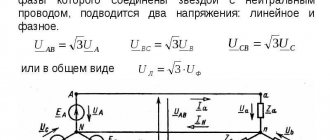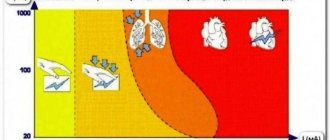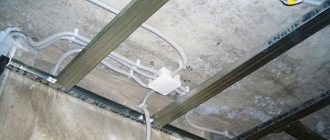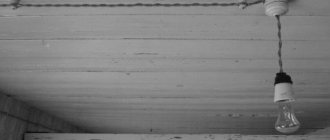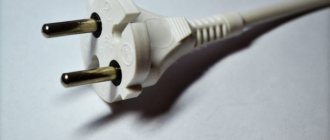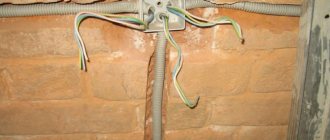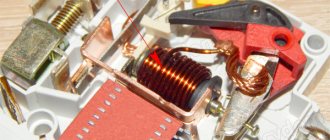The cable is heating up: causes of heating, solutions
Heating of power wires is a common cause of fires not only in production, but also in apartments.
The high temperature of the conductor leads to melted insulation, and as a result, to an open source of fire. If you notice that the cable is heating up, then the cause of its heating should be eliminated immediately.
This article will help in determining such a reason and bringing a household appliance to the appropriate level of electrical safety.
The main reasons for heating cables and wires
To understand the reason for the heating of electrical wiring, you need to remember the basics of electrical engineering. Electric current is the ordered movement of free electrons, in the path of which other atoms of a substance appear. A certain number of such atoms is called electrical resistance. If the resistance is too high, the temperature of the material increases.
An example of securely tightened wires
This principle is successfully applied, for example, in water heaters. In other household appliances or the electrical network, it is necessary, on the contrary, to reduce the heating of the conductors - to bring it to the nominal level.
The main reasons for heating cables and wires:
- The reason why the wire heats up is the choice of its wrong cross-section. When choosing a small cross-section of wires, which haunts almost all would-be electricians, and a constant current strength, a rapid increase in the temperature of the cable occurs. The same principle applies to water pipes - the larger the diameter, the greater the water pressure.
- Overheating of the line occurs due to improper installation. For example, a minor short circuit that does not respond to an overrated circuit breaker. The machine does not open the line - the cable continues to heat up, and after a while it burns out.
- Poor quality connection or oxidation of contacts. Aluminum wires oxidize very quickly, the connections of which should be checked more often than copper wires. In order not to worry about the quality of twisting, it is better to use special terminal blocks or carefully solder the cables.
- Using a low quality cable or wire. Now the electrical equipment market is rapidly filling with products from Korea and China, the quality of which leaves much to be desired. Such a cable, even if installed correctly, can itself cause heating and fire.
Solutions to the problem
If you notice a heating cable, then you need to know how to solve this problem. There are several popular ways to determine the problem and fix it.
What if the neutral wire gets hot?
It is a rare case when the neutral wire in the electrical panel begins to heat up. For example, when recently laying a resistive cable for floor heating in an apartment. You should know that there is no life-threatening potential on the neutral conductor, and its temperature should be within room temperature, but not higher.
What could cause this heating?
- With uneven distribution of currents. This means that at the working zero the current strength exceeds the current that passes through the phases. Self-regulating cables, which are used to heat pipes, lead to this result due to their power. In this case, the zero can not only overheat, but also burn out.
- Poor contact of the neutral wire with the neutral bus. Accompanied by an unpleasant crackling sound and sparking. It is enough to tighten the contact or check the nearest place of twisting and the problem will be eliminated.
- Connecting electrical devices that directly affect the frequency. These are: induction furnaces, pulse consumers, heating cables, LED-based lighting sources, etc.
Consequences of poor-quality neutral wire contact
Conclusion
The above malfunctions are often a consequence of one problem - poor contact. Of course, there are other reasons: poor cable quality, inappropriate circuit breaker, old wiring and much more. But the most common is a contact that interferes with the electrical energy passing through the conductor.
To avoid the consequences of excessive heating of the cable, it is necessary to periodically check the connections in electrical panels and distribution boxes, and, as necessary, tighten or tighten the twists or terminal blocks.
Solutions to the problem
If you notice a heating cable, then you need to know how to solve this problem. There are several popular ways to determine the problem and fix it.
Appliances
Household appliances are the main cause of overheating of the electrical network. Excessive heating of conductors occurs due to the high power of the consumer and the cable not designed for such power. But if this is not the reason, then a simple sequence will help you quickly find and fix the problem.
- Check whether the cable is equally heated along its entire length, or whether a high temperature is observed in one place. A common problem is poor electrical contact between the plug and the cable leading to the household appliance.
How to fix:
- It is necessary to unscrew the bolts securing the fork body and remove the top cover.
- Loosen the wire fastening contacts and remove the wires.
- Clean the wires and contact points - remove all obstacles to the passage of electric current. Then put the wires in their place and carefully tighten the bolts.
- The final stage is assembling the cover.
- Poor cable contact at the input of the household appliance. If the plug is intact, the quality of the contacts is at the proper level, and the wire is heating up on the other side, then you should check the distribution box (or, as it is called, the terminal box) of the household appliance.
How to fix:
- Unscrew the 4 bolts securing the upper cover of the terminal box and remove the cover itself. Below it there is a terminal block in which direct contact is made between the input wire and the wire of the household appliance.
- The block should be unscrewed, the wires should be taken out and stripped, as well as the places where the block is attached. For cleaning, it is convenient to use a small needle file or fine-grained sandpaper.
- After stripping, install the cables into the terminal block, tighten with bolts and replace the cover.
- If the cable heats up along its entire length, and the socket is designed for the permissible current of the household appliance, then there is only one reason - the poor quality of the cable. This conductor should be replaced.
Wiring
Excessive heating of wires in home electrical wiring is accompanied by the smell of burnt insulation and leads to improper operation of household appliances. In some cases, electrical appliances may even fail.
Fault detection sequence:
- The main problem may be the connection location of the power cables in the apartment panel. Usually the input cable is attached to a copper bus, from which the wires will go further into the apartment. A loose contact on the bus leads to gradual heating of the cable, and sparking is also possible. It is enough to strip the wire and tighten the contacts a little.
Important! Stranded copper wires must first be crimped with a sleeve, after which the tip is secured to the busbar using a bolted connection.
- Another reason for an increase in conductor temperature is a weak contact on the circuit breaker or its malfunction. The high rating of the machine leads to gradual heating of the cables, melting of the insulation and its fire. It is enough to turn on several powerful household appliances, for example, a washing machine and a boiler, while the machine is not working, and the result will not take long to arrive.
Poor contact between conductor and circuit breaker - The junction box is one of the most unsafe places in electrical installations. One under-tightened twist leads to burnt insulation and a possible short circuit. Therefore, it is better to make all connections in distribution boxes using copper terminal blocks.
Useful tips
When performing repair work on an electrical circuit, it is important to follow a few tips. Let's highlight the main ones:
Let's highlight the main ones:
- Always check the voltage level before carrying out repairs.
- If possible, call a specialist for electrical repairs.
- Install high quality machines. This requirement also applies to wires, sockets and switches.
- For safety, use cotton tape (it provides better insulation).
- The appearance of visual damage or thinning of the metal indicates the need to replace the socket.
Please note that electricity is deadly and should not be trifled with. If any problems arise with the outlet, junction box or input panel, it is better to fix the problem immediately.
Delaying repairs often leads to aggravation of the situation, damage to household appliances and even a fire.
Additionally, working on an electrical circuit without the proper knowledge may result in exposure to voltage, serious internal injury, or death.
Why does the extension cord get hot?
Heating of the extension cord is an unpleasant drawback of Chinese and other inexpensive carriers. Heating is often observed when connecting powerful household and other appliances. It happens for the following reasons:
- Insufficient cross-sectional area of the conductor;
- Unreliable connection with contact elements of sockets or carrying plugs.
Heating occurs when the extension cord is wound on a reel or bobbin. This occurs as a result of inductive action, when heating is catalyzed by the appearance of magnetic oscillations. When connecting powerful equipment through a carrier, make sure that it is unwound along its length and does not form multiple folds or intersections that can create a negative impact.
Careful attention to the heating of conductive elements will avoid fire hazards and extend the life of household appliances. You can eliminate problems by initially entrusting the calculations and installation to a competent technician.
What are the dangers of poor connections and connections?
Poor contact of current-carrying wires when connecting to each other and at the points of connection to devices leads to heating of the contact points. Why do the contacts get hot?
The physics of heating of poorly made contacts is explained by a simple law of two physicists, Joule and Lorentz. Let me remind you:
The heat generated is proportional to the square of the current, the resistance of the conductor and the flow time.
With good contact between two metal wiring elements, the heat generated by the current has a very specific value, which is calculated and taken into account when choosing the cross-section of conductors and the ratings of circuit breakers.
When the contact is broken, at short distances of such a violation, or, more simply put, when the contact is weakened, the resistance begins to increase, more heat is released, and the contacts begin to heat up.
The heating of the contacts further enhances the thermal expansion of the connection points, as a result the contact weakens even more. As a result, the contact resistance tends to almost infinity (air specific resistance 1016), heating increases.
Added to the heating of the contacts is the sparking of the contacts, which is accompanied by a colossal release of heat. As a result, burnout of contacts, burning of installation products, or, as the most dangerous option, a fire in the house.
Physics of heating
According to the Joule-Lorentz law, “The amount of heat released per unit time is proportional to the product of the square of the current in the area and the resistance of the conductor.”
Then everything is simple:
If the current increases in a section of the circuit, then the heat generated increases by the square of the current, that is, very strongly. Without an emergency, the current in the circuit may increase as the power consumption increases, for example, you plugged in a powerful household appliance or plugged many household appliances into one outlet. This is the first reason for heating the wires.
The increase in heat generated may be associated with an increase in the resistance of the current flow section. This property is used in all electric heaters where high resistance coils are heated. In wiring, an increase in section resistance may be due to weakening or oxidation of electrical contacts when connected by a conductor or connected to each other.
These two reasons, a significant increase in power consumption and weakening of the electrical contacts in the circuit, are the main reasons for the heating of the conductors and the reason why the wiring heats up is most likely in them. You can read: Major electrical hazards in the home
The main reasons for heating the wiring cable and power cord of electrical appliances
Heating of the supply wire is an extremely dangerous phenomenon that requires immediate elimination. But before you begin repairs, you need to understand where and why heating occurs. In this article we will look at the main causes of heating and how to eliminate them. So, let's begin.
yandex.ru
Why might the cable or power cord get hot?
So, let's start by defining the main causes of heating. There are several main reasons, namely:
1. The cable or power cord cannot cope with the current load.
2. The wiring was installed incorrectly and this causes heating.
3. Wire connections are not made properly.
4. Unsatisfactory quality of the power cable or cord.
These are the main reasons for cable heating, now let's talk about them in detail, immediately looking at solutions.
How to solve a problem
First, let's look at the case when the power cord of an electrical appliance gets hot.
So, first of all, determine the heating location:
– the area near the power plug gets hot.
– the area near the electrical appliance itself gets warm.
– or the entire power cable heats up.
So, in the first option, there may be two reasons: this is poor contact of the wires inside the plug itself. And the solution is this: disassemble the fork and, if necessary, tighten the bolted connection.
The second reason may be the socket itself: due to intensive use, the sponges of the socket do not securely fix the plug and because of this, heating occurs in this place. The solution is as follows: ideally, change the socket to a high-quality one with special pressure springs. But if this is not possible, then simply use pliers to squeeze the contact jaws
Attention. Work on the socket can only be done after the circuit breaker supplying this line has been turned off and the absence of voltage has been checked using a multimeter (indicator).
Another option for heating an outlet is that its rating does not match the current flowing. Perhaps your outlet is rated for 10 A
, and you connect a powerful electrical appliance to it.
is
only to replace the outlet with a more powerful one, rated for 16 A.
yandex.ruIf your cord is heating up near an electrical appliance, then poor contact is also to blame. To eliminate this, open the housing of the electrical device and tighten the bolted connection on the device itself.
But if your entire power cord is heating up, it means that a careless manufacturer saved money and instead of, for example, installed a wire with a cross-section of 1.5 mm2 with a cross-section of 0.75 mm2. In this case, only a complete replacement of the power cord will help.
Now let's look at the reasons for heating the wiring itself
Let's start with the most banal and common reason. In many houses there is old aluminum wiring and when it was laid it was designed for single loads, but now the electrical loads on the network have become disproportionately greater. And because of this, the wiring begins to overheat. In this case, there is only one way out: a complete replacement of the wiring in the house (apartment).
yandex.ru
It is also a very common scenario when the wire in the distribution panel overheats. The reason for this lies in poor contact or incorrect connection.
For example, if a flexible wire is used, then connecting it to a machine or to a grounding bus without prior crimping is strictly prohibited.
yandex.ru
Heating can also occur in distribution boxes. The reason is the same - poor contact. In order to eliminate this problem, it is necessary to replace the twists with a high-quality connection, for example, crimping with sleeves.
yandex.ruImportant. If copper and aluminum are connected in a distribution box, then such a connection can only be made through special connecting terminal blocks
Also, all work in distribution boxes and panels must be carried out with the voltage removed.
Separately about extension cords
I also want to talk separately about extenders (surge protectors). Many people are mistaken that if there are 4 sockets in an extension cord, then you can plug a load of 16 Amps into each of them,
So, to each socket of such an extension cord you can connect a load designed for
16/4 = 4 A.
And if you are using a drum-type extension cord, then when connecting, for example, welding, be sure to completely unwind the wire from the drum. Since in the wound state, inductance appears in the wire, which additionally heats it up, and this can lead to melting of the insulation.
Conclusion
In residential premises, the main reason why wiring heats up is that the permissible load on a given group of electrical wiring or the entire room as a whole is exceeded.
In a normal situation, with such an excess of the permissible power, the circuit breaker or protection device should operate. But they also fail, or, even worse, they are deliberately overpriced, for example, they put a “bug” instead of a cork.
Related articles: A clear example of an apartment's electrical project
All this leads to heating of the wiring, which sooner or later will end, at a minimum, in failure of the wiring or, at maximum, in a fire.
Important! If you begin to constantly smell the smell of heated plastic, it is difficult not to notice it, it means that your wiring is heating up and it’s time to take a closer look at it.
©Ehto.ru
More articles
Similar
The wiring in the apartment is heating up
There are several possible reasons for overheating of current-carrying conductors, namely:
- the cross-section of the cable or wire is not able to withstand the load from the connected household appliances;
- The electrical wiring was installed incorrectly, resulting in overheating of the cable line;
- poor quality wire connection;
- poor quality of the cable itself.
Now we will look at instructions for determining the malfunction, and will also tell you what to do if the cable gets hot in one case or another.
Causes and solutions to heating cables
Heating of power wires is a common cause of fires not only in production, but also in apartments. The high temperature of the conductor leads to melted insulation, and as a result, to an open source of fire. If you notice that the cable is heating up, then the cause of its heating should be eliminated immediately. This article will help in determining such a reason and bringing a household appliance to the appropriate level of electrical safety.
What does heating the wiring cause?
The mode of operation of the electrical circuit in which the wiring is heated CANNOT be called operational. This is a situation close to emergency and here's why.
Perceptible heating of wires (cables) means that the temperature of the current-carrying core increases, and the core begins to heat the insulation and sheath of the cable.
The core insulation material and cable sheath have very specific temperature characteristics, exceeding which leads to their destruction (melting). As a result, the insulation ceases to fulfill its main task, insulating the current-carrying conductors. This results in a short circuit and the entire wiring line needs to be replaced.
Related articles: Washing machine electrocutes
Faulty plug
There is no point in delaying repairs - the socket may spark and an unpleasant burning smell will appear. In addition to equipment failure, it is simply dangerous, for example due to the risk of fire or electric shock. It is necessary to limit the use of sockets and plugs, or better yet, stop.
If smoke or other serious signs appear, turn off the electricity. Usually the switch is located in the meter on the distribution panel. You need to hire a specialist or fix it yourself. Work is carried out after a power outage.
If the plug breaks, you can replace it or try to repair it.
What is the reason
In most cases, sockets burn out due to multiple excess power of various electrical appliances that are connected to it. You should know that on the body of any outlet there is relevant information in numbers that helps solve the problem before it occurs. You just need to know the power of electrical appliances connected to the network and compare these numbers with those indicated on the outlet.
If several devices are simultaneously connected to one outlet, this will certainly cause an overload, the resistance will rise and the outlet will begin to heat up quickly. To prevent heating of both the plug and the outlet itself, it is important to control the extent to which power sources are loaded.
Often, the reason for an insecure connection between the socket and the plug is the unsatisfactory fixation of the plug with the connectors inside the socket. Old-style plugs from the times of the USSR are still very common, but their electrodes are almost a millimeter thinner than the electrodes of modern sockets, and the electrodes themselves are located at the same distance on both types of sockets.
Overheating of the neutral conductor - why is it dangerous?
You don’t need to be a specialist to understand the fact that excessive overheating of the neutral conductor can subsequently lead to its burnout, and as a result, cause emergency situations.
So, for example, if in apartment buildings a three-phase power supply network is used (zero is common, and the phases are distributed alternately between apartments), then burning out the neutral conductor will inevitably cause phase imbalance, with the possibility of increasing phase voltages to linear values (380V). Naturally, without additional protection in the form of a voltage relay, household appliances with such power supply parameters will certainly fail.
When using a single-phase supply voltage, if the neutral conductor breaks, a potential will remain on its conductors (through switched-on consumers), which is dangerous to humans.
Why does the socket on the washing machine get hot?
In order to prevent short circuits, burnt wires and thereby prevent damage to household electrical appliances, it is necessary to regularly check the condition of the sockets.
After all, it is always easier and cheaper to prevent a minor breakdown than to later pay for your sluggishness not only with money, but possibly with your health. If the outlet is heating up, then you should not hope that the reason for this will simply disappear, without outside intervention.
Heating of the outlet can be caused by various reasons, including:
- Excessive power of electrical appliances connected to the outlet.
- Unstable contact of the plug inside the socket.
- Malfunction of the connectors inside the socket.
- The contact of the socket clamp is not tight enough.
Why are there short circuits in wires and contacts?
The main factor of a short circuit is a breakdown of the insulation of current conductors. Violation of the integrity of the insulating sheath of wires, breakdown of contact resistance in an electrical or electronic circuit - all this causes a short circuit.
The main causes of short circuits include:
- high voltage surge;
- insulation wear;
- mechanical damage;
- penetration of foreign objects;
- lightning strike.
High voltage surge
Voltage fluctuations in the centralized power grid are often observed in remote areas of rural areas; such cases also occur in urban environments.
During a voltage surge that far exceeds the permissible standard, the risk of breakdown of the insulation of wires or electrical circuits increases sharply. A situation is created in which the wiring shorts and a short-term arcing may occur.
Insulation wear
The old dielectric sheath of wires dries out over time and can self-destruct. Failure to replace old wires over decades often leads to short circuits.
Mechanical damage
External mechanical impact on the electrical network leads to damage to the insulating layer of conductors. An example of this would be drilling into walls with hidden wiring. A drill caught between the wires causes a short circuit.
Penetration of foreign objects
Dust and small debris that get inside the housing through the cracks of the ventilation grille of an electrical or electronic device most often provoke the occurrence of a short circuit between the elements of the device. Short circuits are sometimes caused by insects and small rodents.
Lightning strike
Natural electrical discharge “attracts” the electromagnetic field of various electrical equipment. A powerful magnetic circuit can become the target of lightning.
Eliminate Heat
Before you begin to troubleshoot any problems associated with electrical appliances, you must first stop the current supply to them. To achieve this, you need to turn off the machine, or unscrew the plugs on the electrical panel, after which the cover is removed from the socket, which is secured with a screw in the central part of its body.
If it is noticeable that the contact wires have been exposed to high temperatures, then this is the reason for the heating of the socket. To bring them back to normal, you need to completely remove the socket from its socket, after loosening the screws that secured it. After this, clean the contacts and place them back into the contact clamps, properly tightening the mounting screws. Then the socket is assembled and installed in its place.
Tags: machine, sconce, view, choice, switch, house, , clamp, replacement, sign, cable, like, , magnet, installation, multimeter, voltage, nominal, skew, potential, principle, wire, manufacturer, , work, relay , repair, socket, switch, row, light, LED, network, connection, wire connection, resistance, ten, type, current, , phase, filter, shield, electricity, electrical panel
Causes of overheating
Very often, especially in old apartments with a minimum number of electrical outlets, several electrical appliances are connected to one outlet. And what’s even worse is that when connecting a boiler, various extension cords and tees are used, but not all of them are of the proper quality. What's next? Two or more contacts are added: water heater, washing machine, food processor, etc. The equipment can provide a load of 6 kW or 30 amperes. All this “good” requires wiring with a cross-section of 4-6 mm2, but in fact, only a cable with a cross-section of 2.5 mm2 and a plug with a 10-amp socket are available. This will all lead to overheating and possible fire.
The second reason the plug gets too hot is when the water heater is plugged into an old, unsuitable 6.3 amp outlet or faulty wiring. The plugs of all devices are different and thick pins simply break the holes, after which thin plugs “walk” in the socket, burn out and lose their elasticity. Such manipulations with turning electrical appliances on and off lead to poor contact with the connected water heater, and the plug and socket become very hot. It also happens that when you move the plug, the socket sparks. What follows from this? A separate electrical outlet must be installed for the boiler. If, after connecting, it turns out that the plug is a little wobbly in the socket, then it is better to replace it. To prevent overheating, you need to regularly inspect the plug, wire and socket, and at the slightest trace of overheating, take appropriate measures.
There is an option for the plug to overheat, but the socket remains at normal temperature. This happens when the problem is only in the plug, i.e. the wires are not connected correctly or poorly. If the plug is disassembled, the problem is eliminated without replacing the entire element. In the case of a non-removable plug, it is replaced with a new one.
If the wire gets hot, there are two options:
- the connected water heater wire has a cross-section of less than 2.5 m2 and requires replacement;
- there was a breakdown of the heating element on the body or charring of the wire connections in titanium. In both cases, the supply of electricity increases. It is urgent to carry out repairs before sparking occurs.
Timely detection of the problem and its elimination will help save the life of not only the boiler, but also its owner.

